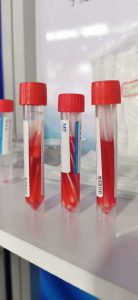なぜウイルスのサンプリングとトランスファーチューブが必要なのか
2020-10-19
なぜウイルスのサンプリングとトランスファーチューブが必要なのか?
ウイルスの流行やウイルス疾患の研究に関係なく, より安全でより正確なウイルスサンプリングチューブ/トランスファーチューブを持つ必要があります. HIVIRALTMウイルスサンプリング/移動チューブがヒメディアが生成しました, 国際的に有名な生物会社, ウイルスの活力と毒性をよりよく維持し、ウイルス検出データをより正確にすることができます.
使用中に注意が必要な問題
1. ウイルスの分離は、正しい標本収集方法に依存します, 標本収集時間と標本処理方法.
2. 標本収集は、病気の急性段階で実施する必要があります.
3. この製品を使用しないでください:
(私) 培地の色が変わりました
(ii) 培地が漏れたという証拠があります
(iii) 培地の劣化の兆候があります.
4. ウイルスの感染性を維持するため, 収集から処理までのサンプルの温度は非常に重要です. サンプルは、サンプリング後、できるだけ早く研究室に送信する必要があります. サンプルは内部で2〜8℃で保存できます 48 収集時間とアイスバッグで輸送されます. 48時間を超えると予想される場合, ドライアイスで輸送し、-70で凍結するものとします。.
5. 収集されたサンプルの繰り返しの凍結と解凍は避けてください.
6. サンプルの収集と処理のための標準手順と公開された手順を参照することをお勧めします.
 1 の 41 米国の人々. 感染しています
1 の 41 米国の人々. 感染しています
テスト方法: 1. サンプリング前, サンプリングチューブのラベルに関連するサンプル情報をマークする.
2. さまざまなサンプリング要件に応じて, サンプリングスワブを使用して、鼻咽頭をサンプリングします.
3. 特定のサンプリング方法は次のとおりです:
私) 鼻腔スワブ: 綿棒の先端を鼻腔内の鼻口蓋にそっと挿入します。, そして、ゆっくりと回転して停止して1分間終了します. 別のスワブの鼻で反対側を拭きます, サンプリングソリューションにスワブヘッドを浸します, そして尻尾を捨てる. ii) スワブを飲み込みます: 綿棒で首尾咽頭扁桃と後部咽頭壁を拭く, サンプリングソリューションにスワブヘッドを浸し、尾を破棄します.
4. スワブをサンプリングチューブにすばやく入れます.
5. サンプリングスワブの部分をサンプリングチューブよりも高く壊します, チューブカバーを締めます.
















